ISSN ONLINE(2278-8875) PRINT (2320-3765)
ISSN ONLINE(2278-8875) PRINT (2320-3765)
M.S.Aspalli.1, Asha.R2, P.V. Hunagund3
|
| Related article at Pubmed, Scholar Google |
Visit for more related articles at International Journal of Advanced Research in Electrical, Electronics and Instrumentation Engineering
This paper presents design and analysis of a three phase induction motor drive using IGBT‟s at the inverter power stage with volts hertz control (V/F) in closed loop using dsPIC30F2010 as a controller. It is a 16 bit high-performance digital signal controller (DSC). DSC is a single chip embedded controller that integrates the controller attributes of a microcontroller with the computation and throughput capabilities of a DSP in a single core. A 1HP, 3-phase, 415V, 50Hz induction motor is used as load for the inverter. Digital Storage Oscilloscope Textronix TDS2024B is used to record and analyze the various waveforms. The experimental results for V/F control of 3- Phase induction motor using dsPIC30F2010 chip clearly shows constant volts per hertz and stable inverter line to line output voltage.
Keywords |
| DSC, constant volts per hertz, PWM inverter, ACIM. |
INTRODUCTION |
| In the present time, in the most of the applications, AC machines are preferable over DC machines due to their simple and most robust construction without any mechanical commutators. Induction motors are the most widely used motors for appliances like industrial control, and automation; hence, they are often called the workhorse of the motion industry[6]. As far as the machine efficiency, robustness, reliability, durability, power factor, ripples, stable output voltage and torque are concerned, three- phase induction motor stands at the a top of the order. Motor control is a significant, but often ignored portion of embedded applications. Motor control applications span everything from residential washing machines, fans to hand-held power tools, and automotive window lift, traction control systems and various industrial drives. All most in all the applications there is a drastic move away from analog motor control to precision digital control of motors using different processors. Digital control of induction motors results in much more efficient operation of the motor, resulting in longer life, lower power dissipation. Although various induction motor control techniques are in practice today, the most popular control technique is by generating variable frequency supply, which has constant voltage to ratio frequency ratio. This technique is popularly known as V/F control [3]. This work describes the design of a 3-phase AC induction motor drive with volt per hertz control in closed loop (V/F) using 16 bit High-Performance Digital Signal Controllers. The system is designed as motor control system for driving 3-phase AC induction motor. The dsPIC30F2010 device contains extensive Digital Signal Processor (DSP) functionality within high-performance 16-bit microcontroller (MCU) architecture. The use of this 16 bit Digital Signal Controllers yields enhanced operations, fewer system components, lower system cost and increased efficiency[9]. According to the requirement, a software programme is written and is fed to the DSC (dsPIC30F2010) for the necessary action. The controller circuit essentially takes the reference speed and actual speed of the motor into account. Depending upon the difference between the reference speed and actual speed, the DSC decides the frequency of gate pulse of IGBTâÃâ¬ÃŸs. The conventional approach of motor control is to first convert the line voltage into DC. DC is again converted to single/three phase AC as per load requirements as shown in fig1[8].The output voltage, frequency or both of inverter can be controlled by the application of power electronics and microcontroller. A closed loop control is normally required to satisfy the steady state and transient performance specifications of ac drives. |
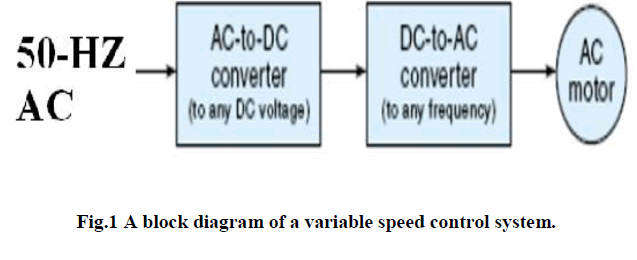 |
| The relationship between synchronous speed, rotor speed and the slip is given by |
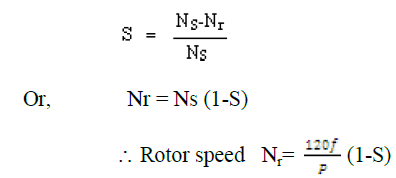 |
| Thus, the speed of an induction motor depends on slip „SâÃâ¬ÃŸ, frequency of the stator supply „fâÃâ¬ÃŸ and the number of poles for which the windings are wound. The ability of varying any one of the above three quantities will provide methods of speed control of an induction motor. Constant V/F method is commonly used for constant and variable speed control of induction motor[6]. |
II. V/F CONTROL OF THREE-PHASE INDUCTION MOTOR |
| The torque developed by the motor is directly proportional to the magnetic field produced by the stator. So, the voltage applied to the stator is directly proportional to the product of stator flux and angular velocity. This makes the flux produced by the stator proportional to the ratio of applied voltage and frequency of supply. Therefore by varying the voltage and frequency by the same ratio, the torque can be kept constant throughout the speed range. The below relations justify the above explanation. |
 |
| This makes constant V/F is the most common speed control of an induction motor. The torque developed by the induction motor is directly proportional to the V/F ratio. If we vary the voltage and frequency, keeping their ratio constant, then the torque produced by induction motor will remain constant for all the speed range. Fig.2 shows the torque-speed characteristics of the induction motor with V/F control. The voltage and frequency reaches the maximum value at the base speed [1].We can drive the induction motor beyond the base speed. But by doing so only frequency varies but not voltage. Hence the ratio of V/F will no longer remain constant. Since the torque developed by the induction motor is directly proportional to the V/F ratio will not remain constant throughout the speed. |
| Other than the variation in speed, the torque-speed characteristics of the V/F control reveal the following: |
| ïÃÂö The starting current is low. |
| ïÃÂö The stable operating region of the motor is increased. Instead of simply running at its base/ rated speed (NB), the motor can be run typically from 5% of the synchronous speed (NS) up to the base speed. The torque generated by the motor can be kept constant throughout this region. |
| ïÃÂö Since almost constant rated torque is available over the entire operating range, the speed range of the motor becomes wider. User can set the speed as per the load requirement, thereby achieving the higher efficiency. Because of above reasons V/F control method is used in this work. |
III. IMPLEMENTATION OF V/F MOTOR DRIVE |
| A. System overview |
| The basic block schematic of three-phase induction motor drive is shown in Fig.3. It has three-phase full bridge rectifier, three-phase full bridge inverter, control circuit, speed sensing unit and output filter. In the proposed work the three-phase bridge rectifier is designed using 6A10BL power diodes. Each power diode is protected from high dv/dt by using metal oxide varistors. The output of rectifier is filtered by 300μF, 900V capacitors. The three-phase inverter has FGA25N120ANTD IGBT switches, with the Snubber circuit for each switch. The output of inverter is filtered by filter. The filtered output is applied to the three-phase induction motor. The digital control of motor is achieved by applying gate pulses from the control circuit to each of the IGBTâÃâ¬ÃŸs switch through optoisolation. |
B. Power circuit design |
| The power circuit is designed using 25A, 1200V IGBT. These IGBTs are protected against surge voltages using Snubber circuit. The 3-phase induction motor is connected to 3-phase bridge inverter as shown in Fig.3. A passive filter at the output of power circuit is used to filter the harmonics. If the upper and lower switches of the same leg are switched on at the same time then this will cause DC bus supply to short. To prevent the DC bus supply from being shorted, certain dead time must be given between switching off the upper switch and switching on the lower switch and vice versa. |
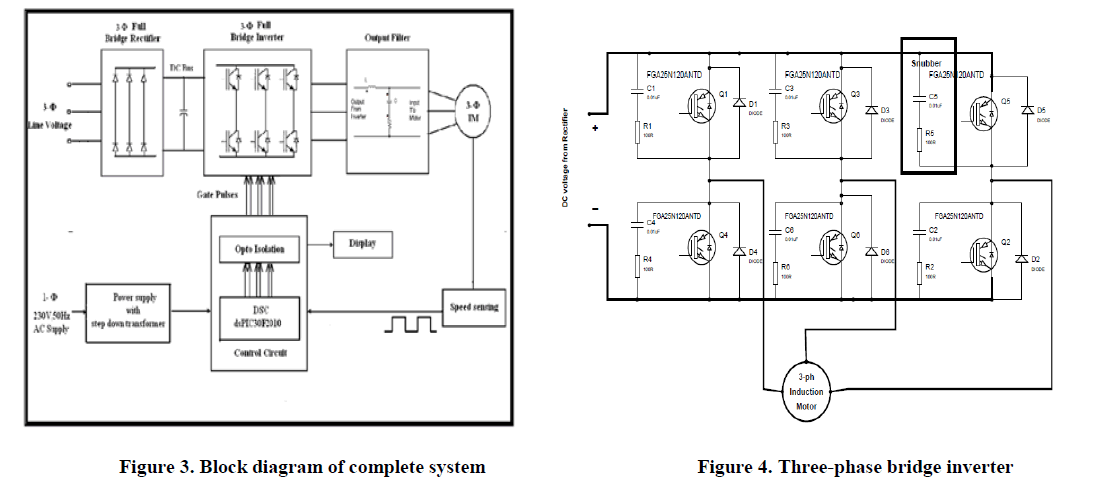 |
C. Control Circuit |
| In this work MicrochipâÃâ¬ÃŸs dsPIC30F2010 digital signal controller is used. MicrochipâÃâ¬ÃŸs dsPIC30F2010 digital signal controllers place unprecedented performance in the hands of 16-bit MCU designers. The dsPIC DSC has the “heart” of a 16- bit MCU with robust peripherals and fast interrupt handling capability and the “brain” of a DSP that manages high computation activities, creating the optimum single-chip solution for embedded control of three-phase induction motor [9]. |
| It also consists of six opto-coupler for isolating the control and power circuits. In this work an optocoupler TLP250 is used to isolate the gate drive circuit and the IGBT-based power circuit. Six IGBTs of the power circuit are controlled by the pulse width modulation (PWM) signals generated by the control circuit. These PWM signals are required to derive a varying AC voltage from the power circuit. A dead time of 2 micro second is given between switching off the upper switch and switching on the lower switch and vice versa, to avoid shorting the DC bus. |
IV. EXPERIMENTAL RESULTS AND ANALYSIS OF SPEED CONTROL |
| The Variable Voltage Variable Frequency drive for a three phase induction motor is successfully developed and tested in power electronics laboratory and the photograph of the complete project setup is shown in figure 16. For different loads and set speeds, frequency and voltage of the gate pulses are tabulated. Textronix TDS2024B Digital Storage Oscilloscope (DSO) is used to store gate pulses and inverter output voltage waveforms. |
| From the table-1 and 2, and from its corresponding graphs, given in fig 5 and 6, it is observed that the maximum torque almost remains constant irrespective of change in load for a particular set RPM. As the torque almost remains constant the actual speed also remains constant which is almost near to set speed with an error of ±15 RPM. From the table-3 |
| it is observed that the V/F ratio remains constant for different loads and set speeds. From the table 4, the speed- torque characteristics are drawn in fig 7, which is similar to the nature of graph for speed-torque curves. |
| The gate pulses are observed for different RPMâÃâ¬ÃŸs & at load 1kg, they are shown in fig 8,9 and 10. The inverter output voltage waveforms for different RPMâÃâ¬ÃŸs are observed, without filter & with filter using DSO & they are show in fig 11,12,13,14, 15 and 16. |
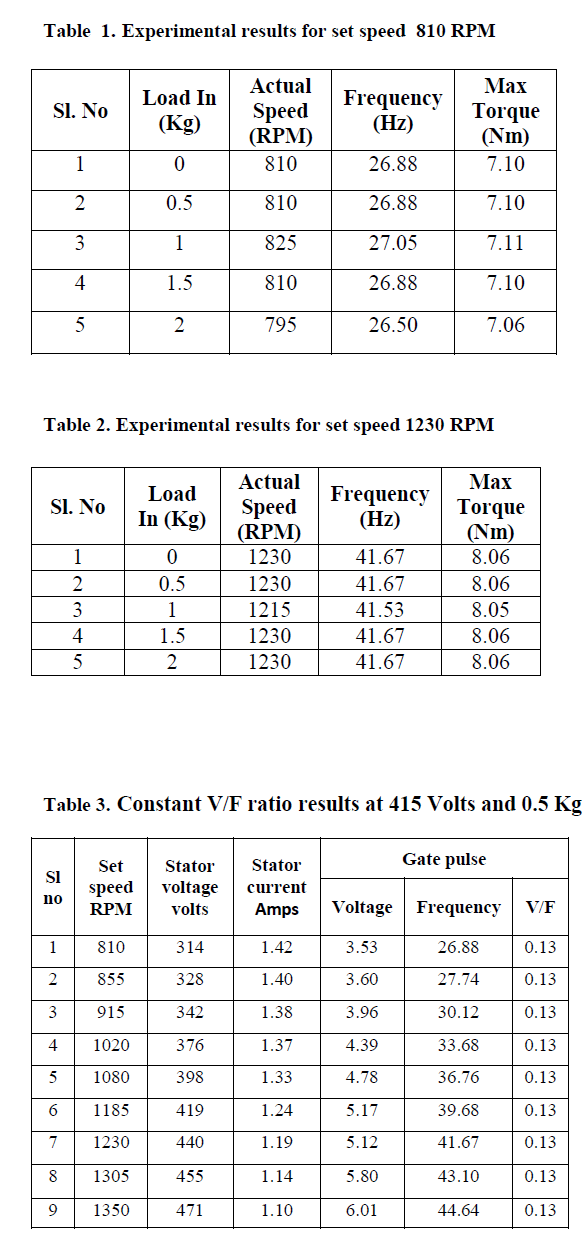 |
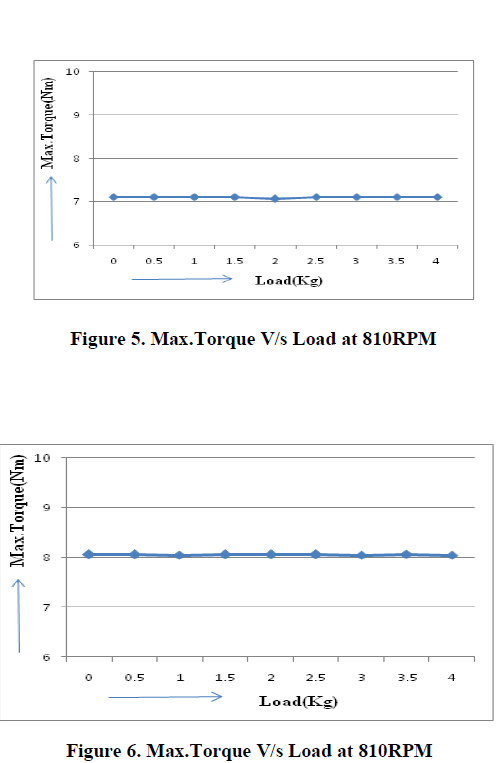 |
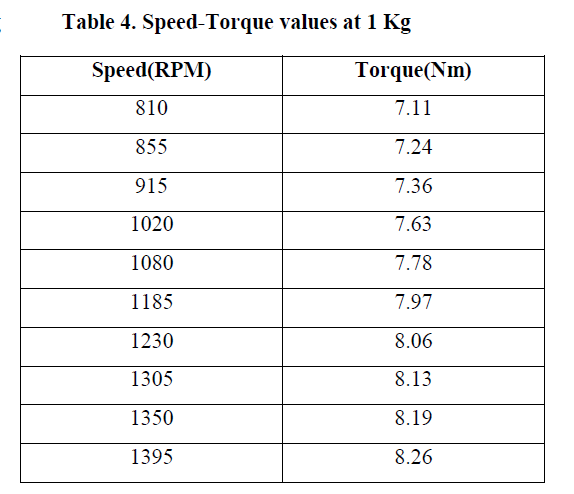 |
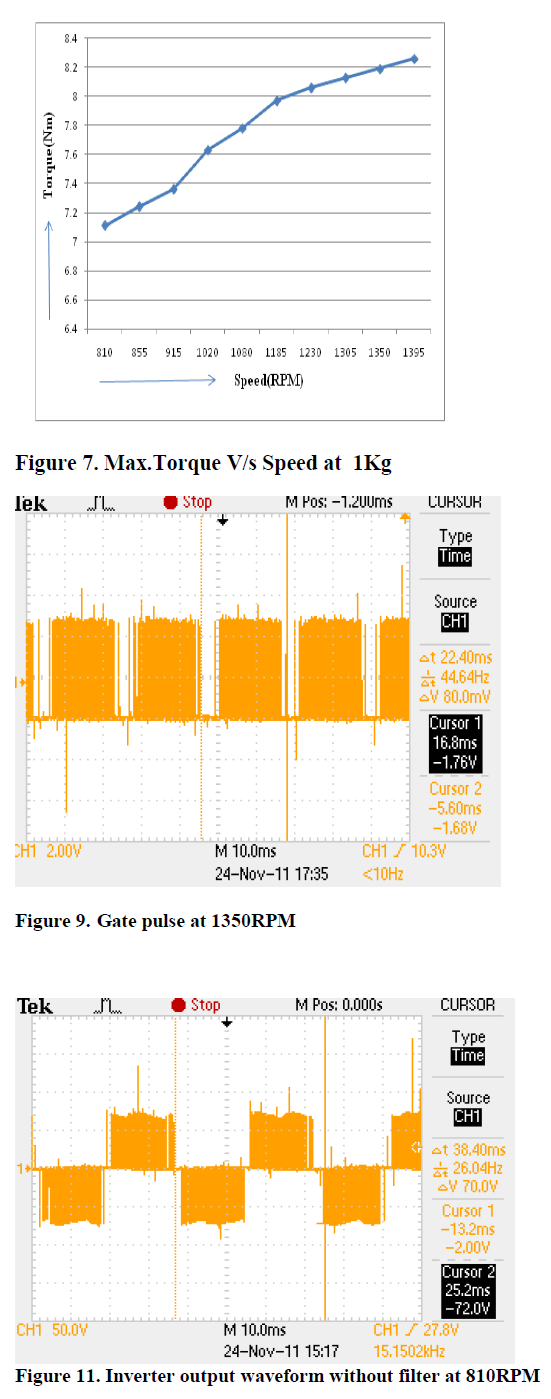 |
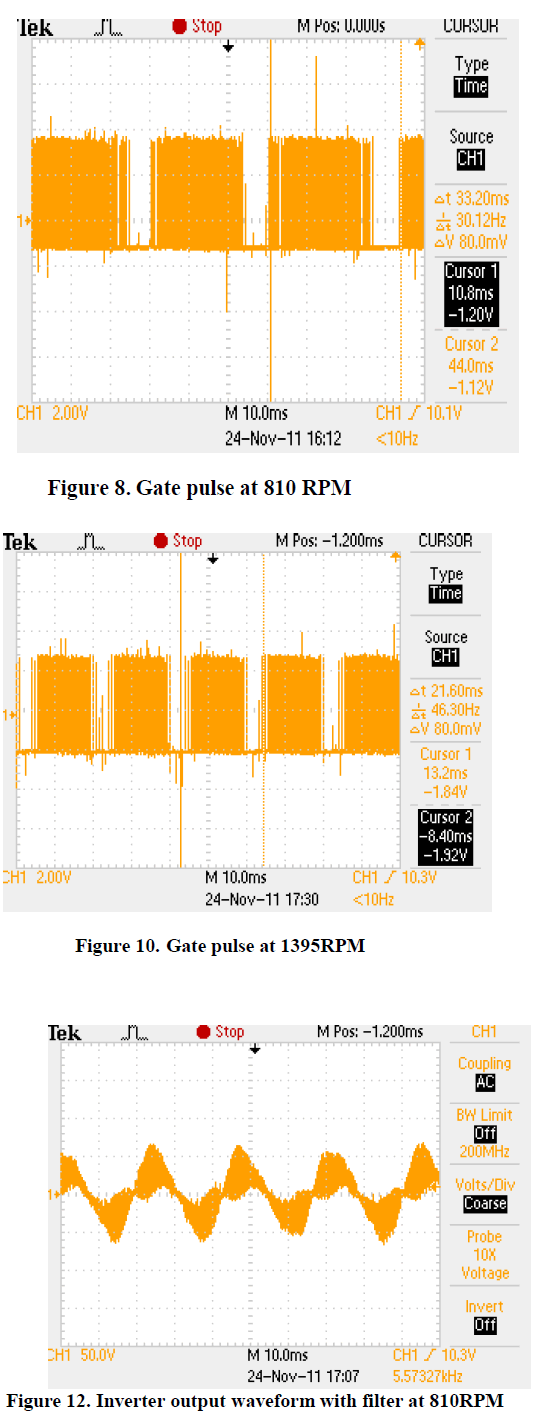 |
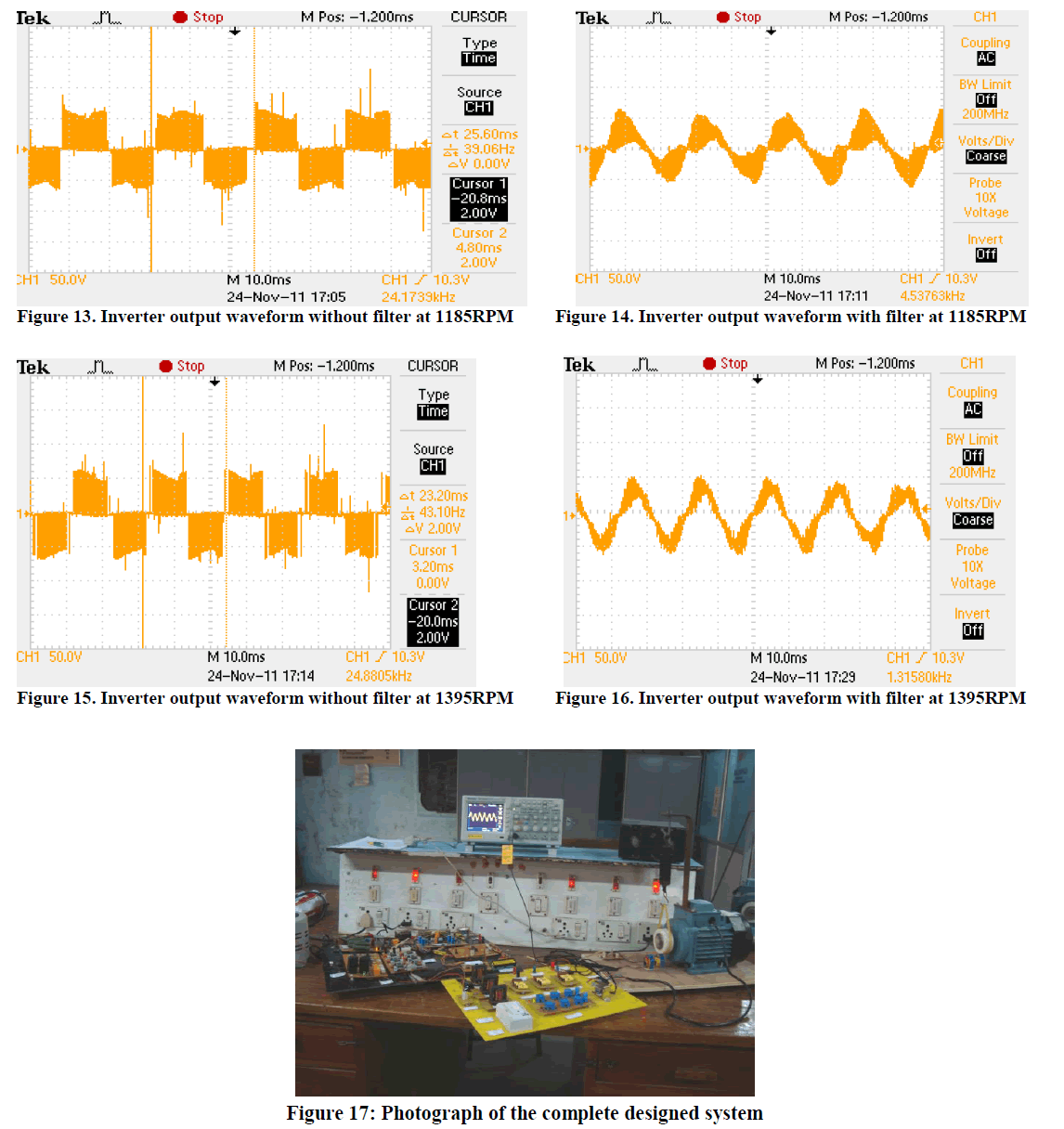 |
VI. CONLUSION |
| A new generation dsPIC approach for the V/F control of three-phase induction motor has been presented. This complete system is developed and tested in power electronics laboratory. Speed control of motor is acquired with the accuracy of ±15 rpm. Hence in this work 98% accuracy of speed control is recorded. The variation of stator voltage and frequency is done proportionally, such that V/F ratio is constant. The inverter line to line voltage recoded is very stable and very smooth with the use of filter. Hence this three-phase induction motor V/F control by DSC is more stable, efficient and economical. |
References |
|